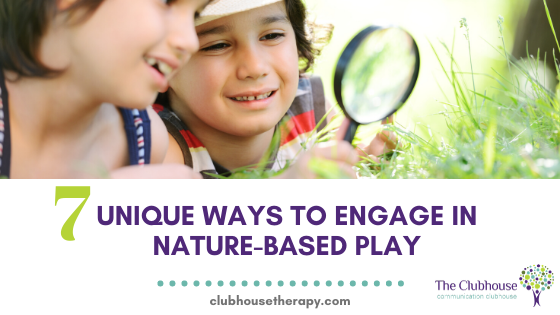Nature-Based Play can foster so many skills! From imaginative play and sensory processing, to motor coordination and cognitive development, the possibilities are endless and this is a great time of year to unplug indoors and reconnect with nature.
1. Outdoor Scavenger Hunt
This is a great way to work on visual attention, visual scanning, and visual discrimination skills! You can make this easy, medium, or hard.
- Easy: lay out the exact match for them, so your child can hold it while going on the hunt.
- Medium: Print images or draw pictures of what you would like your child to find (but try not to make it an identical match).
- Hard: Describe what your child needs to find using descriptive words for the smell, touch, color, size, and shape.
2. Art
This activity works on imaginative play, cognitive flexibility, and visual spatial awareness. Collect materials from all around to make a masterpiece! Use a chalk outline on the ground and create your own design within, lay out a plain piece of paper to decorate, or bedazzle a paper crown. This can also be an opportunity to incorporate teamwork to create something together!
3. Blind Folded Sensory Lab
What a great way to work on sensory processing and exploration! Take turns collecting a variety of items. Whoever is blindfolded must describe how it feels (hard, soft, squishy, rough, smooth, prickly, wet, dry) and make predictions about what they think it could be!
4. Sorting
This activity challenges cognitive and visual attention skills. Sorting helps children understand that things can be alike or different and promotes development for mathematical concepts later in life. The natural world can be divided into countless categories: color, size, parts, shape, texture, etc.
5. Obstacle course
No swingset? No problem! Use materials around you to make a motor relay! Use different motor patterns to make it more challenging (and fun!). Run round the tree, crawl on the grass, hop with two feet over the rocks, walk across a path of sticks, skip to the bushes, then roll down the hill. Write out each step with chalk or on a piece of paper. Incorporate siblings and friends for turn taking and social skills. Cheer each other on!
6. Decorations or Jewelry
This fun activity targets sequencing and fine motor skills. Hole punch leaves and string them. Let children create their own design or follow a pattern of colors, sizes, or types of leaves.
7. Sensory Bin
Don’t be afraid to let your child get dirty. In fact, encourage it! Tactile sensory experiences are essential for children’s physical, social and emotional skills, as well as cognitive and language development. So let them roll in the grass, dig in the dirt, and splash in the puddles. If you are looking for something a little more tame, fill a bin with the cut grass after you mow your lawn, or the extra mulch from the garden you didn’t use. Stones, sticks and rocks are also just as fun! Hide small toys and treasures inside for sorting or just pretend play.
By Emily Case, MOT, OTR/L

